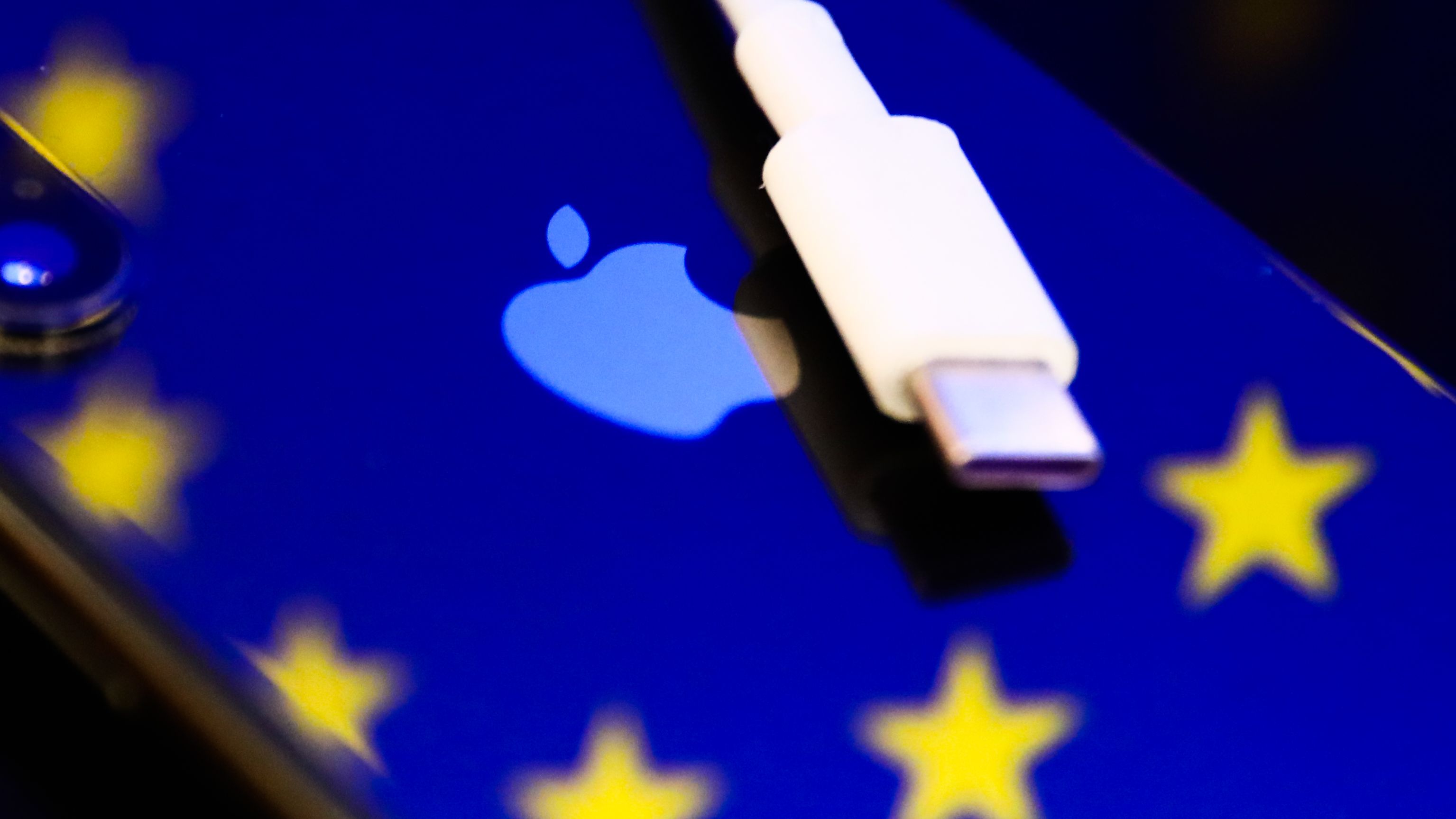Apple faces a catch-22 decision with iPhones and USB-C
The EU's decision to mandate USB-C across all electronics means Apple must either eat its words or anger its loyal customers once again


‘The one that goes into a MacBook’, ‘the double-sided one’, and ‘the oval one’ are three of the most common descriptions for the USB-C standard we hear when talking to the uninitiated, or those who simply aren’t plugged in to the world of modern technology. But that all stands to change with the latest EU ruling that mandates all USB-powered electronics to adopt the standard by “Autumn 2024”. Following official confirmation this week, all major devices will be using USB-C and the name will soon, surely, become universally known.
Of course, we techies are thoroughly attuned to the connectivity standard that will soon make a giant leap towards realising its namesake ambition of becoming universal. Now in USB-C’s eighth year, Apple is one of the last major manufacturers to remain stubborn in its use of proprietary connectivity standards for its hardware. Industry analysts and commentators have long speculated when Apple would make the final switch to USB-C in favour of its Lightning port to power its iPhone, or if it ever would. Those questions still remain, but the company’s options are narrowing quickly thanks to the EU’s latest ruling.
Has Apple been greenwashing?
You’d be hard-pressed to find anyone without a keycard to Apple Park that would oppose a wholesale shift towards USB-C adoption. Calls from all corners of the technology industry to make such a move have been growing louder with each year that Apple unveils yet another iPhone equipped with its Lightning connector - one that can be used only with an iPhone and Apple Watch.
Indeed, the move will be welcomed by many - pretty much everyone, in fact, besides Apple – a company that shamelessly defends its stubborn stance on Lightning with reasons that never quite made sense.
Back when the European Commission first hinted it was considering mandating USB-C across the EU, Apple came out all-guns-blazing to defend its precious proprietary cable, with the gall to claim Lightning actually saves e-waste because customers would need to buy cables they don’t already have. Curious, it is, to make such a claim in a year that saw USB-C’s popularity grow by 24% since its launch, and its uptake is now projected to balloon ten-fold by 2030, according to the latest figures.
That said, we can all assume that Apple is fully aware that everyone has a USB-C cable or three lying around at home, just in the same way it knew everyone had a USB-A power brick lying around when it decided to do away with including it in the iPhone’s box back in 2020. The only difference then was that it benefitted the company’s bottom line - being able to reduce packaging sizes and ship more iPhones per shipment - while neatly masquerading it up as an environmentally responsible strategy.
Apple equips most of its hardware with USB-C; its transition to the standard with MacBooks and iPads drew no significant uproar or customer revolts, so why the hesitance with iPhones, and where does it go from here?
Get the ITPro daily newsletter
Sign up today and you will receive a free copy of our Future Focus 2025 report - the leading guidance on AI, cybersecurity and other IT challenges as per 700+ senior executives
Could Apple bypass USB-C entirely?
The key date for Apple, here, is the “Autumn 2024” goalpost for the law’s enactment. This plays nicely into analysts’ predictions it could move to a fully portless iPhone in its 15th iteration that is due for release, yes, at the earliest estimates, in Autumn 2023. It’s important to note Apple has never confirmed that iPhones will go fully portless in favour of wireless charging, but the signs are there. The iPhone 12 represented somewhat of a step change, being the first iPhone to launch with 5G alongside, crucially, wireless charging, complete with Apple’s trademark, egregiously priced accessories, such as cases and proprietary – USB-C-powered – wireless MagSafe chargers.
This means that Apple may not have to make any substantial changes to its business model at all, providing the iPhone’s future is actually a portless one, and that Apple was intending to go portless in line with analysts’ predictions. But analysts are regularly off the mark, be it wildly or just slightly. Ultimately, Apple has never confirmed what it would do if faced with a forced shift to USB-C, but it has a number of routes it could take over the next two years as the EU finally pulls the plug on Lightning.
RELATED RESOURCE

Third party risk management essentials
How to manage third party risk within your organisation
If Apple did go fully wireless, though, it runs an even bigger risk of public fallout than would a shift to USB-C. There's not a single person in Cupertino that believes people would be more pleased to fork out for a wireless charger than use the USB-C cable they already have from other devices, perhaps even the iPad or MacBook. Maybe there is, but there shouldn’t be.
Taking this route would only fuel the views that Apple ‘goes green’ when it suits Apple, when it wants to hide a potentially unfavourable money-making tactic. Keeping the Lightning cable was arguably never about a responsible e-waste strategy. Apple makes too much money off Lightning cables – the genuine, 100% reliable ones that can only be sourced from Apple itself. The same goes for its MFi program that requires any manufacturer that wants to connect anything to an iPhone to go through Apple. And, of course, it takes a nice little slice from the profits of each of these too.
The time's come to make a decision
Only the engineers at Apple Park would know the financial and logistical expense it would take to shift an iPhone to USB-C, but for a multi-trillion-dollar tech company, it's highly likely it would be capable of devising a cost-effective way of doing it.
This is the real catch-22 for Apple. There are lots of factors at play, and very little time to make a call. It needs to commit to a charging standard and have all the necessary processes in place to make large-scale production feasible and cost-optimised by Autumn 2024. It needs to decide whether it will bend to the EU and offer USB-C iPhones for the first time, or whether to go fully wireless.
Committing to USB-C will force the company to eat its e-waste words from last year and, ultimately, give the people what they want. Sure, they could go for USB-C in the EU only, but that won’t likely sit well with customers in the UK, US, and everywhere else. It also probably won’t make a lot of logistical sense being forced to have factories that assemble one kind of iPhone, to one set of blueprints, and other factories working on another.
That said, Apple isn’t a company that is prone to bending for anyone. It took on Epic Games in a fierce antitrust battle last year and famously shut out the FBI, no less, when it asked for help to track a known terrorist. It would be wholly unsurprising if Apple, once again, like it did with power-brick-gate, does things its own way and goes portless by the time the EU can do anything about it, upsetting a huge swathe of its customer base, albeit hoovering up a lot of revenue in the process.

Connor Jones has been at the forefront of global cyber security news coverage for the past few years, breaking developments on major stories such as LockBit’s ransomware attack on Royal Mail International, and many others. He has also made sporadic appearances on the ITPro Podcast discussing topics from home desk setups all the way to hacking systems using prosthetic limbs. He has a master’s degree in Magazine Journalism from the University of Sheffield, and has previously written for the likes of Red Bull Esports and UNILAD tech during his career that started in 2015.
-
 Bigger salaries, more burnout: Is the CISO role in crisis?
Bigger salaries, more burnout: Is the CISO role in crisis?In-depth CISOs are more stressed than ever before – but why is this and what can be done?
By Kate O'Flaherty Published
-
 Cheap cyber crime kits can be bought on the dark web for less than $25
Cheap cyber crime kits can be bought on the dark web for less than $25News Research from NordVPN shows phishing kits are now widely available on the dark web and via messaging apps like Telegram, and are often selling for less than $25.
By Emma Woollacott Published